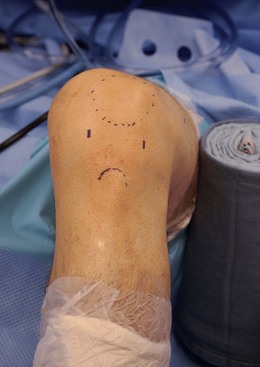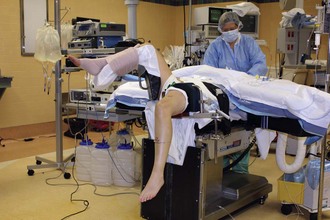Chapter 51 On the basis of the surgeon’s preference, one of two setups is used at our hospital. In the first, the patient lies supine on the table with the feet just short of the end of the table. The nonoperative leg is protected with foam padding. The operative leg is flexed to 90 degrees. A sandbag is taped to the table for the foot to rest on when the knee is flexed. A lateral post is attached the table at the level of the midthigh. The post helps stabilize the leg when a valgus force is applied to visualize the medial compartment. This method allows easy access to all aspects of the knee. However, an assistant may be required to manipulate the leg during the procedure (Fig. 51-1). The other option entails placement of the thigh in a leg holder and flexion of the foot of the table (Fig. 51-2). On the table, the patient’s operative knee must be just distal to the level of the break in the bed. The operative leg is placed into a leg holder that encompasses the proximal thigh. The opposite leg is placed into a well-leg holder and protected with foam under the knee. The operative leg is manipulated by placing it on the surgeon’s pelvis or thigh and applying a varus or valgus stress at the knee. If the leg holder is too tight, it can act as a venous tourniquet and cause bleeding during surgery. Whereas this method eliminates the need for an assistant, there is no support for the leg when it is in extension. Also, larger thighs may not fit well in the leg holder.
Patient Positioning, Portal Placement, and Normal Arthroscopic Anatomy
Patient Positioning
![]()
Stay updated, free articles. Join our Telegram channel

Full access? Get Clinical Tree


Musculoskeletal Key
Fastest Musculoskeletal Insight Engine








